My Year of Driving the Latest Electric, Gasoline and Diesel Technology Cars

What a year! No one should doubt that 2013 was a breakthrough year for advanced technology vehicles, whether running on electricity, gasoline, diesel or some combination of the three. The choices expanded, prices dropped and infrastructure exploded (for plug-ins). This year presents an abundance of riches; as I wrote earlier, we (at least we in California) now have 10 pure electric vehicles to choose from–and 2014 promises and expanded roster of choices. I had the opportunity this year to sample more than half of those available. Add in plug-in hybrids and the list of EV choices almost doubles, while traditional hybrids, clean diesels and high-MPG gasoline vehicles ranks keep growing both in number and popularity.
This year I also had the opportunity to help organize two glimpses at the automotive future — the Western Automotive Journalists’ “Silicon Valley Reinvents the Automobile” and “Future Cars-Future Technology” events. Those programs whetted my appetite for what is coming soon and alerted me to much that is already making its way into our cars and advancing their efficiency.
I didn’t get into every vehicle available this year, so this comes from a limited sample that focuses on the new vehicles. My biggest takeaway from 2013–the toughest job for a new car purchaser is sorting out what vehicle or vehicles can deliver the best for his/her situation. It’s never a matter of pure MPG (or MPGe for the plug-ins), but the type of vehicles that functions for you.
Here are the highlights of the year from my drives with some notes about how the vehicles fit into the many lifestyles out there. The choices are amazing and have been getting better every year. I’m really looking forward to 2014!
Also, I have to add a few more to the Top 10 in a couple categories just because so much has happened this year.
1. 2014 BMW i3 – both EV and range-extended EV. I had the opportunity this year to help out BMW on a project introducing the new 2014 i3 to some folks just after its official “launch” and managed to spend several days squiring around three versions of the lead vehicle in the company’s new “i” division. With this car, available as a pure electric and also with a range-extending motor, BMW follows its Mini-E and Active-E programs with “the real thing.” This car has so much going for it, from a carbon fiber monocoque to a plethora of environmentally friendly features to a price that makes it one of the more affordable BMWs, it’s hard to step back and analyze it.
In my time in the preproduction i3, the reactions to it were almost universally positive. Some skeptics questioned its unique styling, but that appears to be one the points BMW is making. When you see an i3, you won’t mistake it for any other BMW – or any other car on the road. Though small, it’s highly functional, with decent room for four adults (with rear seat access through a hidden rear half-door) and cargo space via the rear hatch. The lightweight car has ample power from its 125 kW electric motor and carried 22 kWh of liquid-cooled lithium-ion batteries underneath its floor panels. Range is expected to be somewhere south of 100 miles and its EPA (MPGe) will probably slot it right in the pack of current similar-size electric cars. With its small range-extender engine and 9-liter gas tank, the i3 will cost a little more but still only deliver about 180 miles or range, keeping the i3 as primarily an urban vehicle.
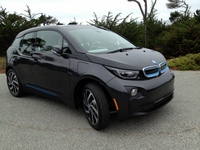
BMW’s approach with the i3 is to present a unique vehicle, a la the Toyota Prius, that is identifiable not only as an BMW and an EV, but one that the company hopes will become the icon of electrics. If that happens, it will displace the Nissan Leaf and Chevy Volt, who, along with the less common Tesla Model S, currently hold that mantle. Early orders from dealers (it will be available nationwide before midyear 2014) have BMW execs excited that they may have a hit on their hands. Tracking the rollout of the i3 during 2014 is one of the stories we’re looking forward to for this coming year. Our experience up to this point indicates that the i3 will delight purchasers the same way the Mini-E and Active-E have. In fact, we predict the i3 will let BMW put its mark on the EV world very quickly.
2. 2013 Ford Fusion Energi – a versatile, stunning cruiser. Spending a week with the 2013 Ford Fusion Energi, the plug-in version of Ford’s best-selling midsize sedan, was eye-opening. After driving small EVs, the Fusion seemed and was a spacious vehicle. A midsize sedan, it could handle five passengers in comfort, or in my use scenario, three adults and luggage for a 600-mile weekend roundtrip. With the battery taking up a portion of the trunk, space was at a premium, but the Fusion handled it all with aplomb. Most enjoyable of all, it didn’t miss a beat on the open highway, delivering a great, comfortable ride balanced with good road feel and handling. Fuel economy was not the 100 MPGe you get plugging it in for local drives, but solidly above 40 MPG on the highway and combined.
The 2-liter Atkinson-cycle gas engine was fine around town and on the highway at speed, but strained on steep hills. The test model came loaded with all the latest technology, including optional active park assist,
adaptive cruise control, rear view video camera and driver assist package with lane keeping and cross traffic alert. With all this technology and a 17-mile all-electric range, the Fusion Energi is the harbinger of future automated cars. It’s standard technology is designed to aid the driver in his/her quest to obtain the best fuel economy. The system teaches you quickly how to brake to maximize captured energy, extending the EV-only range and increasing efficiency.
All in all, the $39,495 (including $795 destination charge) Fusion Energi is full of style and substance. According to EPA calculations, this model will save you $6,850 in fuel costs over five years compared to the average midsize sedan. Of course, if you have a short commute and can plug in at home and work, you can extend the electric range and increase those savings. As it is, Ford’s 2014 pricing has the Energi model starting $8,470 more than the Hybrid model, which in turn is $4,300 more than the standard Fusion. Some quick addition and you can see the Energi models costs almost $13,000 more than the base Fusion. While it may have a higher level of standard equipment, it’s clear that five years of “normal” driving are not going to recoup the additional cost. However, you also can factor in cash incentives in some states and a federal tax credit. In addition, because of its EV-capability the Energi is eligible for solo HOV-lane access in California, which offers a value for commuters that is sometimes hard to measure in dollars.
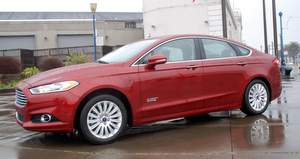
3. 2013 Fiat 500e – spunky gas-free fun. I gave this little electric car two thumbs up when I drove it earlier in the year. It remains the most fun EV I’ve driven and, while not the most practical car because of its small size (and miniscule back seat), it delivers so much in power and handling that it should be on the shopping list of anyone looking at electric cars. The best news is that, while eligible for all of the EV incentives and perks, the Fiat has a retail lease for the same price as its gas cousins.
4. 2013 Toyota RAV4 EV – the only SUV EV. This would seem like a no-brainer. Take Toyota’s bulletproof reputation for quality and hybrid leadership, add in some Tesla EV powertrain magic and drop it into a proven model (one that even has an EV heritage). The 2013 Toyota RAV4 EV has all that and its only limitations appear to be a high sticker price ($49,800 for the 2014 model) and limited availability (Toyota plans to build only a few thousand RAV4 EVs to meet its obligation under the California ZEV Mandate).
With a 100-mile range from its 115 kW electric motor and 845 pounds of battery (with a 35 kWh capacity), the RAV4 EV delivers the typical quiet, smooth and powerful electric vehicle experience. The preproduction prototype I drove was well put together. The model offers the high driving position of an SUV and all of the SUV functionality as the battery doesn’t intrude into the cargo area. Charging on anything less than a 30 amp, 240-volt charger is tedious, though, taking 12-15 hours on a 16-amp station and almost two days using a 120 volt wall plug. Toyota does
encourage installation of a home charger and works with Leviton as their preferred provider, offering reasonable prices for the chargers and installation.
My only issue with the RAV4 EV is one I’ve found on several Toyotas I’ve driven–it doesn’t seem to have much personality. It’s functional, does everything asked and performs as well as much of its competition, but the steering and road handling lack the input I’ve come to expect from the best models coming from Europe, America and Asia. Unlike the Fiat 500e or some of the other models on this list, the RAV4 EV doesn’t leave a memorable driving experience. But what it has going for it is that it’s the only pure electric SUV available, offering the same 70 cubic feet of cargo space (behind the front seats) as the gasoline version. Of course, it’s front-wheel drive only, but then again it’s not likely you’re going to take a 100-mile range vehicle too far into the outback.
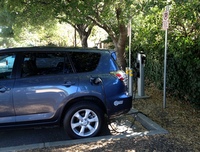
5. 2014 Jeep Cherokee – taking Jeep into new territory in looks and efficiency. Jeep hasn’t made its reputation on styling and fuel economy. It’s know for outstanding off-road ability wrapped in a traditional-looking package and a variety of comfort features that have made it more and more car-like over the years.
The new Cherokee, which I took on a brief test drive, is an impressive step forward. As someone who spent more than half a decade at a magazine dedicated to Jeeps and 4x4s, I witnessed the introduction of the midsize XJ Cherokee in the 1980s, a revolution for Jeep that brought unibody construction to an off-road vehicle and started the movement to upgraded interiors in SUVs.
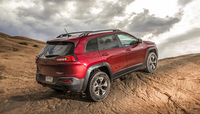
The old Cherokee was surpassed by the Ford Explorer and a variety of other SUVs that expanded the category to become essentially beefed up station wagons, some of which would potentially go off-road. The new Cherokee is a gauntlet tossed down by the new Chrysler/Fiat management, challenging this category once again to find a balance between style, rock-crawling capability and adding in fuel efficiency.
Pricing on the Cherokee appears to be as attractive as the stylish exterior, starting at $22,995 for a front-wheel drive version and ranging up to $29,995 for a 4WD Limited model.
My time in the Cherokee was brief so I didn’t get a chance to test its off-road abilities or do a full-tank fuel economy run, but the vehicle promises 31 mpg highway with its 2.4-liter MultiAir and 9-speed transmission. In Trailhawk trim has all of the 4WD features that have helped Jeep build and keep its off-road reputation. I’m looking forward to some extended seat time and a chance to see how this model lives up to the Jeep reputation.
6. 2014 Jeep Grand Cherokee EcoDiesel – the survival of the big SUV. This is almost a no-brainer as well. Take an SUV with a solid reputation as both an off-roader capable machine and a smooth highway
Jeep’s New MPG Tool
operator and boost its fuel economy by 30 percent without sacrificing any performance. The Grand Cherokee, which once boasted a diesel engine borrowed from Mercedes, now gets one from Fiat. The 3-liter V-6 is quiet and powerful (240 horsepower and 420 lb-ft of torque), capable of towing more than competitors’ V-8 engines. It’s fuel economy is 20 percent better than the Grand Cherokee’s base V-6 gas engine and more than 40 percent better than the V-8 option.
Again, I only had a brief drive, but as has been the case with the diesel option in the big German SUVs (Mercedes’ GL, Audi’s Q7 and BMW’s X5), I would expect that this will be a popular option in the Jeep. Chrysler added an 8-speed transmission to the diesel (and other engine offerings) as part of the MPG-boosting package. It looks like with 2014 models where the EcoDiesel is available, prices will start at around $46,000. This is another one I hope to get more time in during 2014 to get a better feel for how it operates in the real world.
7. 2013 Nissan Leaf – still the leading pure electric car. Like my colleague John Faulkner, I spent a week in a Nissan Leaf this year and came away impressed with the car’s capability. We may dwell too much on the shortcomings of an EV when the real story is how much utility they have. With its real-world 70-80 mile range, the Leaf can handle most commutes (especially if workplace charging is available) and make around town trips for days without recharging. I tested its range on one evening excursion and found that, combined with a smartphone app that shows available charging stations, trips at the edge of the range could be handled without stress.
The Leaf takes on the country
In addition to my week with the Leaf, I also had the opportunity to take one on an extended drive from the Nissan plant in Tennessee. That drive pointed out two shortcomings of the car: (1) long-legged drivers taller than 6-foot-2 are likely to find the cabin cramped and less than comfortable, and (2) the Leaf is not really cut out for freeway passing. As is always the case with EVs, you’re going to spend more time calculating the length, terrain and outside temperature on a given trip (compared to a conventional gas car), but the learning curve is short and your experience will quickly raise your confidence for making longer drives. However, it remains an unnerving experience to watch your range steadily drop as you power down the freeway at 70 mph; ironically, it reminds me of the gas guzzlers of the 1960s where you could sometimes see the gas gauge needle move when you got on the accelerator. The Leaf remains a smooth, quiet performer. It’s easy to operate and can actually accommodate five adults, at least for short runs, and still retains some storage space in the rear hatch. Its styling is distinctive without being too eccentric. With the price drop that Nissan engineering this year, the Leaf appears to be reaching an audience beyond the early adopters and is starting to find its way into the garages of folks just interesting in low-cost, low-emissions transportation.
The Leaf remains one of the premier ways of getting there on electrons alone and, at least in California, is one of the models dealers are offering with discount pricing, special lease deals and a variety of options.
8. 2013 Chevy Volt – the best of both worlds. The Chevy Volt, like the Nissan Leaf, has made its mark in the EV world. Intrepid Clean Fleet Report reviewer John Faulkner called it “the best GM car for the money” and I would be hard-pressed to disagree. From the beginning more than two years ago the Volt has been a bargain given the technology involved in the car. It’s fascinatingly smooth and responsive, delivering a great driving experience along with its excellent fuel economy. Unlike my experience with the Leaf, trip planning was effortless as the gas-engine backup was always available. On the other hand, plugging in regularly made around-town driving a pure electric experience.
I found the Volt very stable in crosswinds, probably due to its low center of gravity created by 435 pounds of batteries arrayed down the center of the car. The electric drive was more than needed for freeway
Volt offers versatility
acceleration. It featured less aggressive regenerative braking than the Leaf, but still managed to extend its EV range. Even with an extended trip, I averaged just under 50 MPG with the Volt. It’s purely a 4-passenger vehicle, but the Volt has good room in the back seat and luxury appointments throughout. The luxury touches differentiate it from the Leaf, which has more of an everyman feel. Of course those luxury touches include options that took the price of the Volt I drove from just under $40,000 to more than $45,000.
It’s a lifestyle choice. The Leaf is a solid second car, potentially a commuter and definitely a go-anywhere-around-town champ. The Volt can do all of that and adds the ability to throw in a long-distance trip (250 miles round trip in my case) as well. Beyond functionality, the Volt does have more luxury appointments and imparts a more upscale aura. It’s not surprising the two models have become the poster children for the move to electric drive.
9. 2013 VW Jetta Sportwagen TDI – a highway cruiser, SUV substitute. Let’s get this out of the way first. I really like diesels. Yes, the fuel is typically more expensive than gasoline. Yes, the stations are a little harder to find. Yes, the engines make a little more noise. But look what they offer in return for these “inconveniences” – great, consistent fuel economy, turbocharged power and, in the wagon version, a luggage-gobbling vehicle that keeps a sedan profile and road manners.
So, Volkswagen in the not-too-distant past had a period when it was known as the “diesel Rabbit” company since that was its best-selling (and almost only) product in the U.S. Those diesels, for those who remember them, were very fuel efficient, but also slow, loud and smelly. Thankfully, as VW enters a new diesel era, those attributes are, like the Rabbit diesel, a thing of the past. Today’s diesels, such as the Jetta Sportwagen TDI I drove, have great highway manners and are smooth around-town performers as well. It’s not hard to see why the vast majority (more than 80 percent) of Sportwagen’s leaving American showrooms sport TDI engines. My test model featured a smooth-shifting 6-speed manual transmission, black leatherette interior and a panoramic sunroof. At its heart (and soul, when you think about it) was a 2-liter, 140-horsepower, 236 lb-ft of torque four-cylinder diesel engine. As sweet as this engine is, delivering a consistent mid-40s MPG on the highway, VW is about to replace it next year. The new model will be smaller and lighter, get better fuel economy but produce more power and have even lower emissions.
The lack of options on my test Jetta kept its price down ($28,390 including destination charges), but other than an HVAC system that seemed overmatched by the California-Nevada deserts even in springtime, it didn’t seem to be missing much. The car was a comfortable highway cruiser, topping its EPA 42 MPG highway regularly even with the speedometer pegged between 75 and 80. Around town it delivered the 34 MPG as advertised and offers the height of functionality in a compact package.
10. 2013 Smart ED – finally getting it right. Up front, I should disclose that I owned a gasoline Smart for several years. I had no issues with the car, although it was limited in use because of its size. Smart cars are not long-distance highway runners and with only room for one passenger and several grocery bags, taking one on a Costco run would only end in frustration. So, in some ways, the Smart is one of the most logical cars to turn into an EV. Of course, it doesn’t hurt that its design from the beginning is suited for electric drive and other alternatives. Daimler AG’s decision to electrify the Smart makes sense since it already has limitations like most EVs – it’s primarily a city car built around short trips, tight parking places and fuel economy-minded individuals.
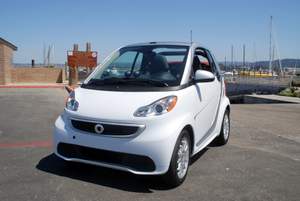 The Smart ED I drove this year represented the third generation of the electric Smarts, one that finally appears to have nailed it. The first round used zinc-based batteries that caused a variety of issues, according to reports at the time. The second generation, which I drove last year, leveraged Daimler’s relationship with Tesla for battery management and related technology. My brief drive at the time left me wondering whether Tesla really would make it (a concern since answered by the company’s solid performance this year). It lacked power, was wholly inadequate on the highway and just seemed ill-suited for anything but short, flat city drives.
The Smart ED I drove this year represented the third generation of the electric Smarts, one that finally appears to have nailed it. The first round used zinc-based batteries that caused a variety of issues, according to reports at the time. The second generation, which I drove last year, leveraged Daimler’s relationship with Tesla for battery management and related technology. My brief drive at the time left me wondering whether Tesla really would make it (a concern since answered by the company’s solid performance this year). It lacked power, was wholly inadequate on the highway and just seemed ill-suited for anything but short, flat city drives.
Thankfully, the third generation of one the most oddly named (check out the disambiguation under “health”) cars on the market appears to have things sorted out. Daimler has again changed batteries (now a 17.6 kWh package from Deutsche ACCUmotive) and uses a 55 kW electric motor that I am happy to report from a short drive is more than adequate to California’s typical roads. Though only boasting a 60-80 mile range and costing almost double the gas version of the Smart, the Smart ED deserves a look for those into a city car lifestyle. The range is not an issue running around most urban areas and Smart is already running discount deals like the other EV makers.
Small but finally right.
——————————————————-
That’s my 10 best, most-interesting vehicles of the year that I had the pleasure of piloting. It is not everything I have driven or written about and unfortunately one of the downsides of this kind of format is that some deserving cars get left off for no reason other than they’re the 11th or 12th most interesting cars of the year. In a field with the potential of hundreds of vehicles, ranking that “low” is not really a negative mark, so here are a couple just below the Top 10.
One that my colleague John Faulkner has had a chance to evaluate fully is the Jetta Hybrid. I was fascinated by the technology involved. Unlike many other hybrids out there, the Jetta focuses not only on fuel economy (which it delivers quite well, though I was never able to equal the EPA highway or combined ratings of 48 and 40 MPG) but also on performance. The turbocharged engine delivers great low-end torque and also was responsive throughout the powerband. Jetta’s hybrid features aggressive regenerative braking a feature that was unnerving at first – coasting on the highway the engine will shut off, then instantly restart whenever you touch the accelerator.
Another model that didn’t make my list, but is worth mentioning in a positive light is the latest version of the Honda Civic Natural Gas. Having been in earlier versions of the Civic GX, I was expecting to be underwhelmed. The experience was just the opposite. The Civic running on natural gas was as close to a gasoline Civic as one could expect. Filling up on CNG is getting easier as well, though I still consider this model as much of a challenge as an EV and in some ways even more because of lack of development of a home refueling infrastructure.
Those two are relatively easy (and I could probably expand the list as well), but there were also two vehicles I experienced this year that not only would not make my Top 10 list, they would be unlikely to end up on my recommended list at all. That said, both vehicles have their adherents. The Mitsubishi i-MiEV and Prius c are two vehicles that live at the bottom, price-wise of their respective classes. Unfortunately, my experience with them only reinforces that sometimes you get what you pay for.
The i-MiEV is the adaptation of a Japanese market vehicle and while the changes for this country are noticeable and positive, it’s not enough to make this a competitive vehicle among electrics. With the price wars, EV affordability has become something of a level playing field and Mitsubishi’s competitors offer much more in vehicle comfort and features. It’s not that the i-MiEV is not a competent and functional electric car. It works, but acceleration lacks what is found on the Fiat 500e or RAV4 EV. Its steering is somewhat vague after driving European or most American sedans. If there were no other EVs out there or no other price competitive EVs, you could probably make a case for the i-MiEV, but that is not the case.
The smaller Prius – less is less
My time in the Prius c was limited, but I did get a chance to give it a pretty thorough challenge on the road, heading up over the Laureles Grade in Carmel Valley and hitting some high-speed roads around Monterey. The “c,” which adopted the Prius name even though it is based on the smaller Yaris platform, is a compact car based on the EPA’s interior volume characterization, but it feels more like a subcompact. Toyota advertises the “c” as the “snug Prius,” which I can’t argue with. It’s small and has a proportionately small engine that didn’t appreciate the extreme grade I pushed it up. Handling also seemed kind of soft, but not out of line for Toyota’s approach to the U.S. market.
The Prius c’s main appeal seems to be its low price. Since its introduction, the “c” has been the entry-level Prius, allowing the larger original Prius to move upward in price and options. It does deliver on fuel economy, but for me the sacrifice in performance and space is not worth the meager savings.
My final category is a twofer – the prototypes I’ve driven and the ones I’m looking forward to in the coming year, some of which are the same. First up is the E-Golf, which I’ve driven in several prototype forms over the past couple years. The models I’ve driven seemed ready to head to the showroom, but it will probably be late next year before the electric Golf shows up on these shores. I did take a short drive in the Chevy Spark EV (and John Faulkner gave it a full review). I plan to put some time in one soon to see how it fits in the developing hierarchy of electric cars. My initial impression is pretty positive. Of course, high on my list of unobtainium is the Tesla Model S. I have a neighbor with one and see them daily (haven’t seen one on fire yet–that’s a joke, Elon), but haven’t given one a proper test, although again all reports I’ve seen and heard have been quite positive. And add the new fuel cell Hyundai Tucson that goes on sale this spring. And I’m sure there will be some good surprises as well. Happy New Year, indeed!
Story & Photos by Michael Coates
Posted Dec. 30, 2013
Other related stories you might enjoy:
Top 10 Best-Selling High MPG Cars of 2013
Top 10 Best Fuel Economy Cars of 2014
Hydrogen Fuel Cell Electric Cars Go On Sale in 2014

0 thoughts on “My Top 10 High-MPG Cars of 2013”